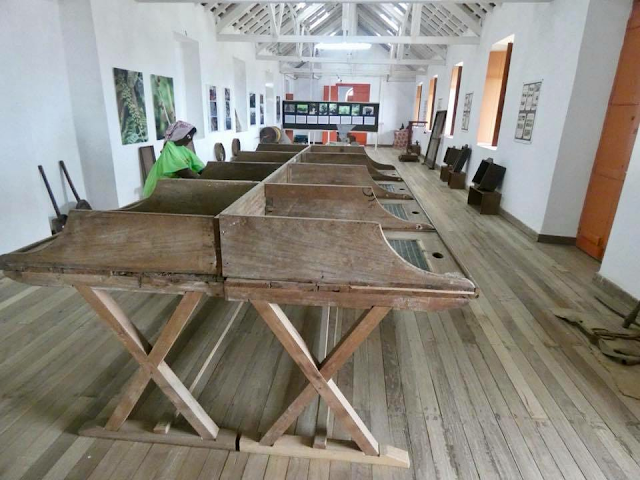The Coffee Mountain (Monte Café) Plantation oozes history
(All photos by author)
A visit to the Coffee Mountain (Monte Café) Museum in Central Sao Tome proved to be an eye opener. On the way to the museum, I passed through coconut oil factories. By the way, Sao Tome produces some of the purest and most aromatic coconut oil in the world. Monte Café is also close to the charming São Nicolau Waterfalls.
Located on a hillside village in Trinidade district about 670 meters above sea level and 10 kms from downtown Saotome, the Roça Monte Café used to be one of the oldest and largest coffee plantations in the country. Today, with a population of just over 2000, the village is the site of the ruins of the 19th century coffee plantation, still frequented by tourists.

The English-speaking guide at the museum gave me a detailed tour of the premises and explained with great passion, the entire process of coffee production, right from the harvest point till the end product. According to him, Monte Café (Coffee Mountain) village enjoyed ideal and favourable weather conditions for growing Arabica and to a lesser extent, Robusta varieties of coffee. With the abundant growth of coffee, the site soon became the largest and earliest coffee plantations of São Tomé in 1858.
Inside the museum, the graphic photographs depicting slave trade, the colonial coffee processing machinery and the ruins of the old complex transported me mentally to the 1860s.
From the vivid description of the guide, it was clear that the people of Sao Tome were initially reluctant to work in the coffee plantation, as they were still scarred by the painful memories which they endured at sugar plantations earlier. But gradually, they were eased into the process with persuasion and promise of better pay and service conditions. So, as the coffee production increased, so too did the number of plantation workers.

Delving deep into history, he explained how the local farmers used to bring their produce to the collection point every day, where they were weighed and paid at a fixed rate by the cooperative per kilo. After that the seeds was fed into the processing machines to sort them by size and then subjected to multiple rounds of skin removal procedure. They were later segregated by shades of colour and finally roasted. The guide informed that the entire process of weighing a day’s harvest till roasting took about a week. Apparently the best quality seeds were reserved for the personal consumption of the Portuguese owners.

A wage register at the museum suggests that at one point, more than 1300 workers were pressed into service. The register contained their names, neatly handwritten in black ink and which also showed the amount due and paid to each worker. The average wage was about 8000 escudos per month (Euros 9). But from all accounts, Monte Café was one of the few successful plantations, which also benefited the farmers of Sao Tome.

The guide showed me the run-down buildings which had once housed the living quarters of the colonial masters, school, hospital, coffee processing areas and large eating place. They are all in a dire state today. The coffee museum is the only well-maintained structure.
A panoramic view of the entire site clearly showed a well connected and self contained Rocha with all facilities including school and hospital. Some of the photos depicted the existence of narrow gauge rail tracks used to ferry the harvest to collection point and to ship the end product to market chains outside the plantation. Of course, none of the tracks exist today. Among the other interesting bits of information whispered by the guide, was that the colonial masters employed only the prettiest of girls in the processing unit.
After independence of Sao Tome in 1975, the plantation was nationalized. But it lost its production capacity and soon the entire complex fell into utter disrepair. This is the predicament of many other nationalized plantations as the fledgling country had no technological and material resources to maintain the pre-independence infrastructure.
Roca Monte actually still produces some coffee. I could see small patches of coffee plants, along with other agricultural produce like vegetables and fruits. I also detected several Porcelain flower (national flower of Sao Tome) trees growing nonchalantly along the edges of steep mountain roads.

Today, the area is dotted with small but independent hamlets and cliff houses. Cheerful school kids, hard-working mothers and working men speeding on motorbikes, complete the picture.
The visit filled me with a poignant sense of history, was also a pleasant and rewarding experience. For three euros, the museum tour reinforced the high touristic worth of the place. I also got to taste a cup of the strong aromatic Sao Tomean Arabica coffee at the end of the museum tour.
https://www.transcontinentaltimes.com/2022/04/24/sao-tomes-monte-cafe/







Comments
Post a Comment